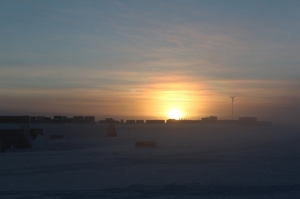
March 21, 2013: The Equinox – the technical date that the sun, as a point, sets at the South Pole. On a perfectly spherical earth, with no topography, no atmosphere, no height above the ground the sun would be exactly halfway below/above the horizon on this day …Of course this isn’t the case, so our sunset is a little more variable. Since reaching a peak height of 23.5deg (the tilt of the earth) on the December solstice the sun has slowly spiraled towards the horizon. For the past few weeks we have witnessed increasingly beautiful displays of gold, pink, and purple light. Shadows stretch exponentially and the sun spins around us, just skimming the horizon, moving as much as 15deg an hour. Inside it has become noticeably darker, with lights turned on in the galley and my room nearly dark at night. This is a pretty big deal for us winter overs as the sun rises and sets only once a year here at the South Pole – events witnessed solely by those who commit to winter here, a total 1389 people (197 women)since 1957.
Due to a combination of phenomena, the sun is still visible today and will likely remain so for a few days yet. Even after the orb ducks below the horizon we will have a few weeks of light, phasing from daylight to civil twilight (0-6º below horizon) to nautical twilight (6-12º below) astronomical twilight (12-18º below) and eventually to full darkness. The moon rises and sets on a two week cycle, the brightness of which can be significant, so we will not be in full darkness for the entire winter. That said, it will be pretty dark for a good ~4 months.
The next moonrise is March 26th, but the sun won’t show it’s light again until the next equinox (vernal for us in the Southern hemisphere, autumnal for those of you further North) on September 21, 2013.
The latest update from the Coldest Journey which has just begun their trek to the Pole:
www.thecoldestjourney.org
A few factors that influence the actual sunset are variable topography, air densities, and thermal inversions. The topography at the South Pole is not completely flat and uniform as it might seem, gradual undulations over miles create nearly imperceptible hills and valleys. These become noticeable this time of year with the sun appearing to be right on the horizon at noon and a few degrees above at 5pm. Strong thermal inversions exist here as well which can significantly refract the light, making the sun visible many days after it has technically set. The refractive effects of our atmosphere can make the sun appear to be flattened or squished against the horizon, or deceptively higher than it actually is, and is the cause of the green flash (LOTS more on the green flash and refraction here: http://aty.sdsu.edu/) – a phenomenon that has been visible for several hours in past years. Today it’s quite cloudy, but here’s a photo of a green/blue “flash” taken in 2000 by Rodney Marks:
 And some more from 2003 (photographer unknown):
And some more from 2003 (photographer unknown):
And here are some of my photos of the sun taken this year:

And so begins the longest night…















Hi-
I found your blog a few weeks ago and I’ve really enjoyed reading it. I noticed that you mentioned that at the South Pole there have only been 197 female winter overers compared to +1300 men. I thought I also read something that this year there are 7 women winter overing out of 44 people total. Why such a large difference? I imagine in the past women were not allowed/encouraged to winter over but now a days why still the discrepancy?
Thanks,
D.
I’m not sure – I think it’s a matter of fewer women applying to these jobs. A lot of the positions are trades/mechanical and I think the general pool is unbalanced to begin with. If you know any women who want to come down encourage them to apply! 🙂
Thanks for the reply! That is what I was wondering – if the winter over positions are more often traditional male jobs. Very interesting. I am actually applying for positions for the 2013-2014 season so we’ll see what happens.
Best,
D.
Pingback: Equinox « I tell stories
Pingback: Summit Sunsets | AntarcticArctic
Pingback: South Pole Sunrise - Antarctic Logistics & Expeditions
Pingback: Halos | AntarcticArctic
Pingback: Sunrise! | AntarcticArctic
Pingback: The Long Arctic Winter | AntarcticArctic